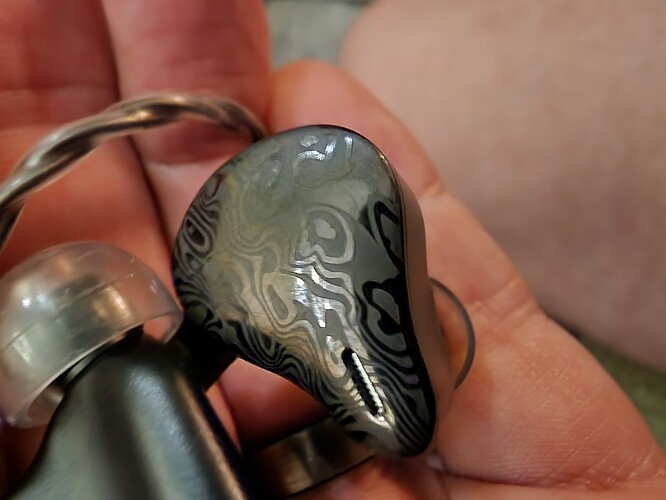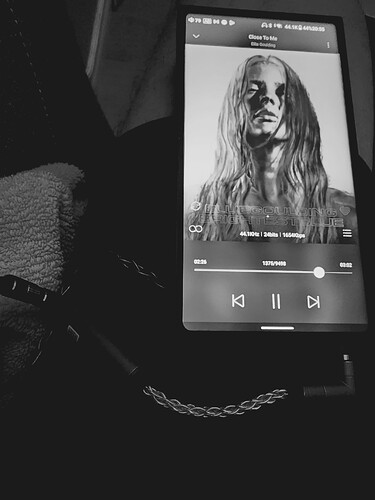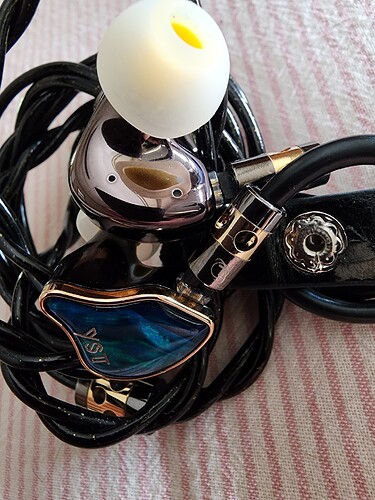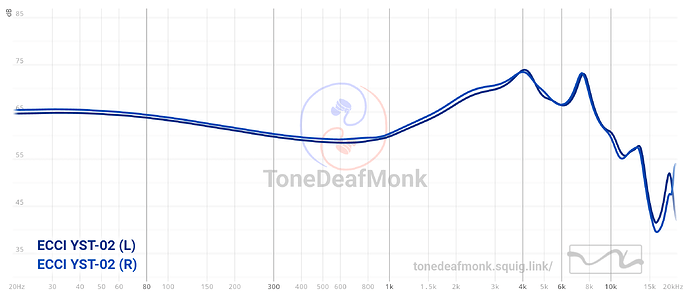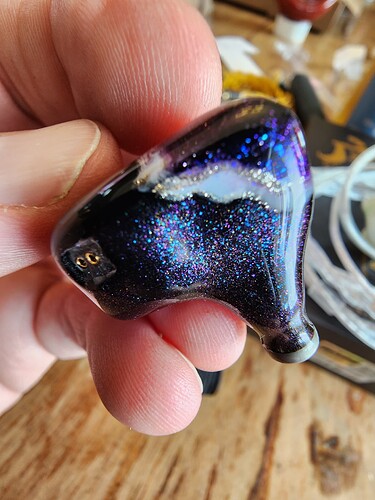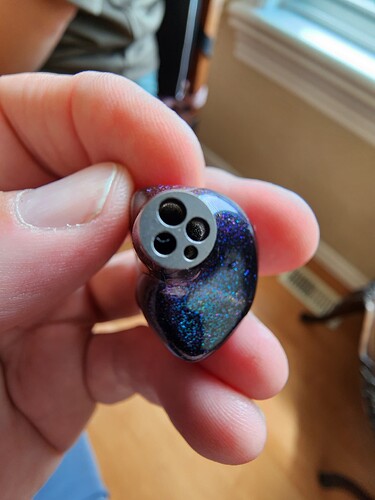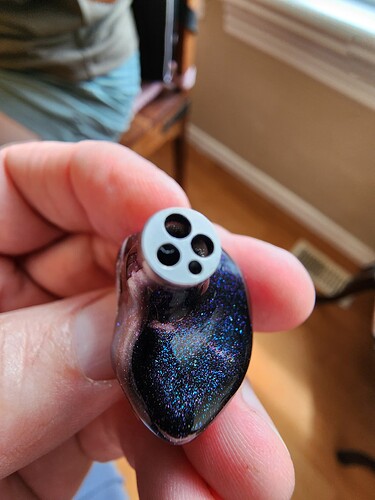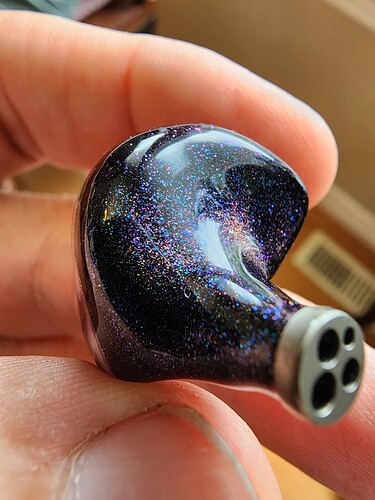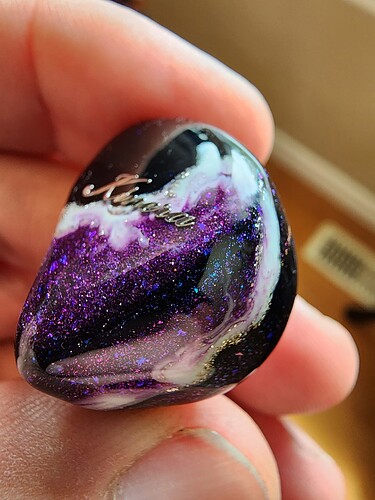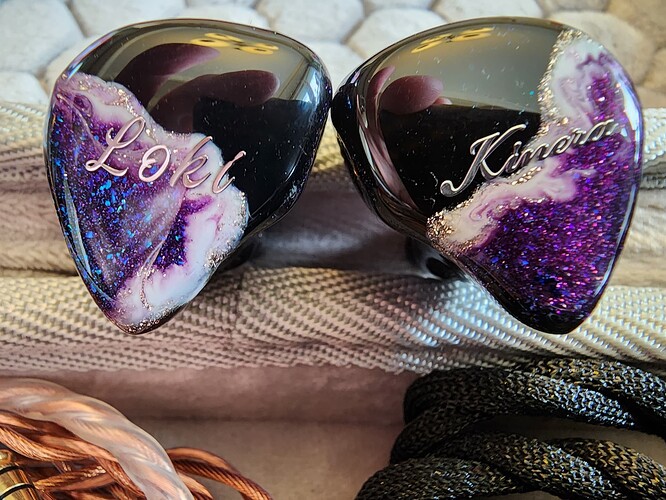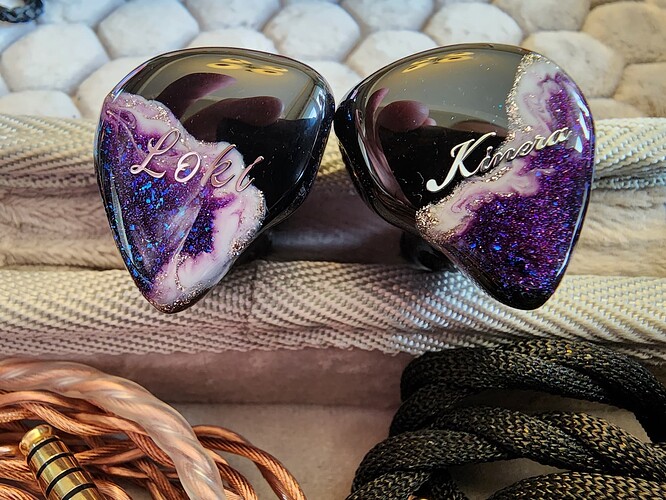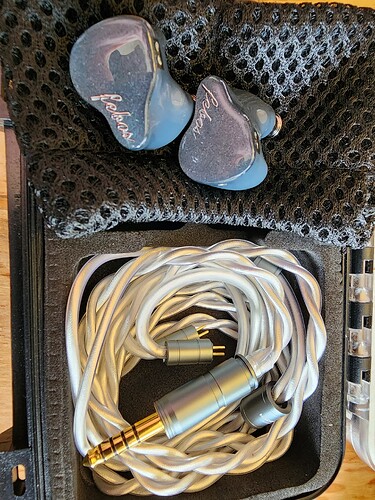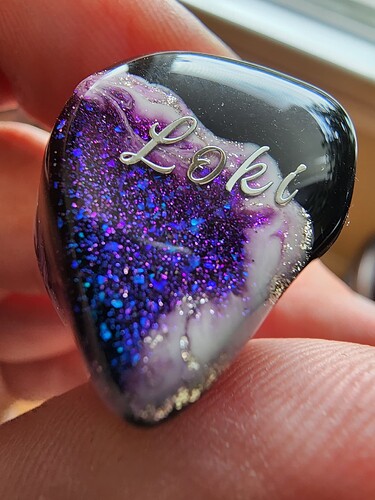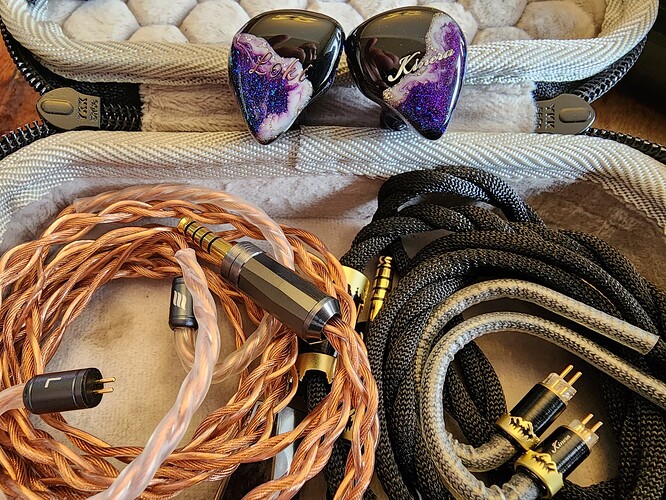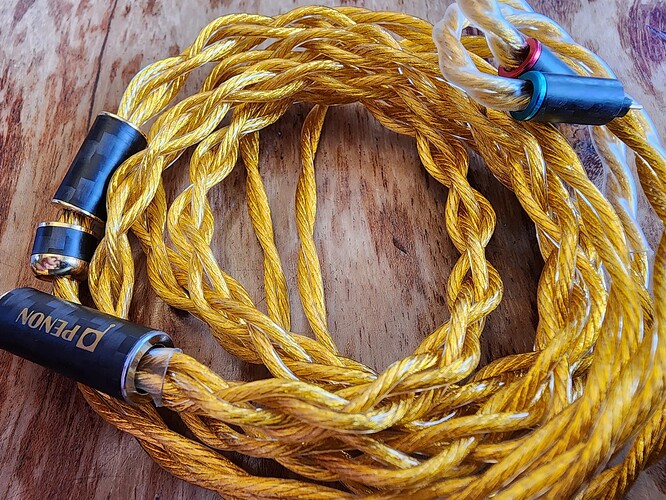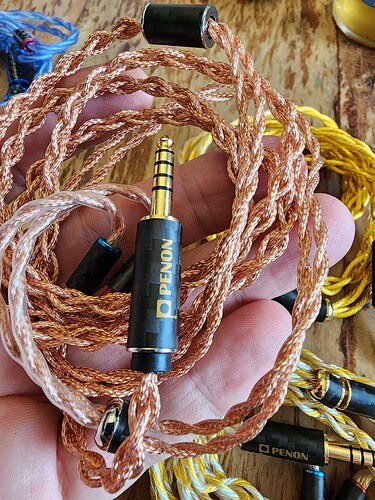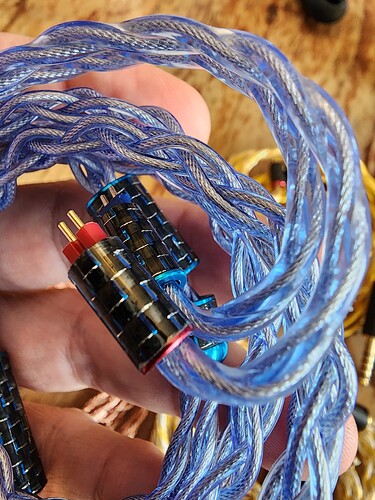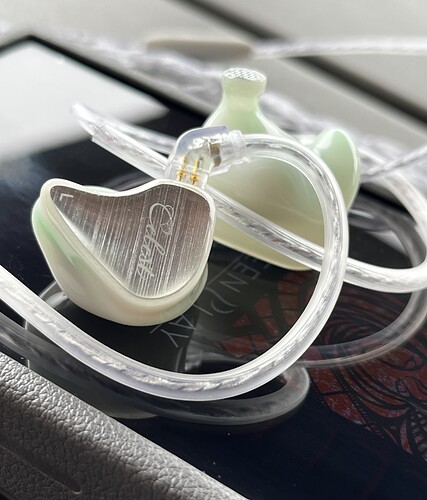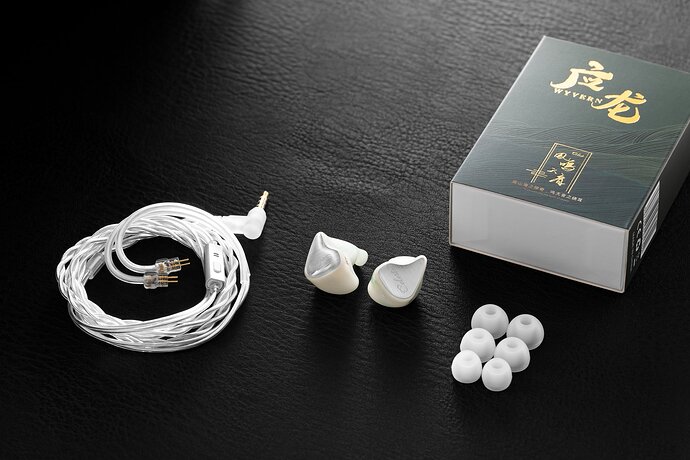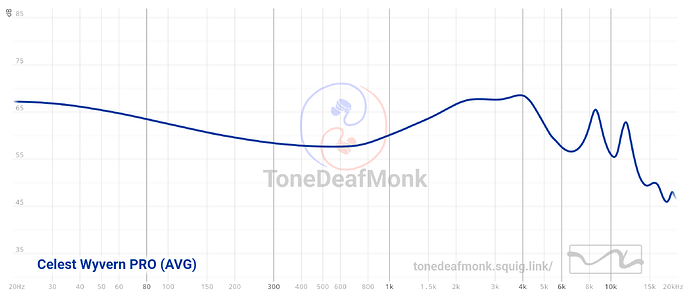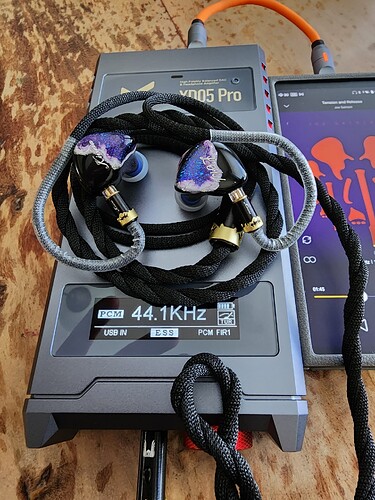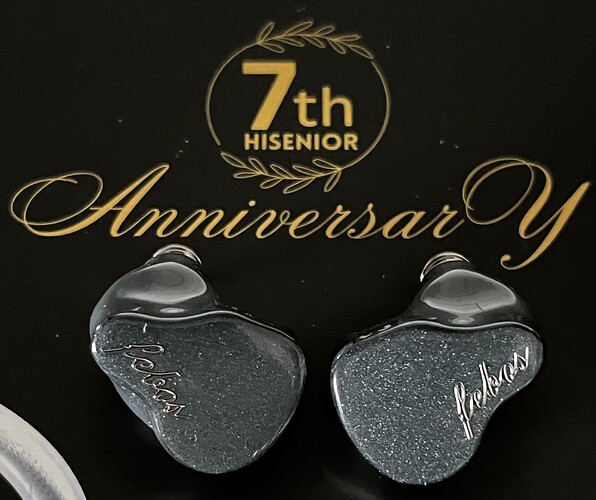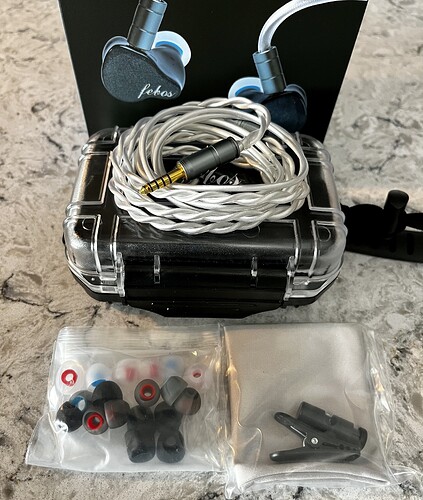it looks pretty amazing ngl
Ok these are interesting vocals play back in the mix with subtle sub bass boost and the instruments are slightly forward in the mix. A new tuning for me. Very cool.
I find Vulkan kind of having an amphitheater-style tune: vocals in the center but instruments kind of wrap around them (which gives you that slightly sitting back feel)
I just came off of the Okavango and vocals are slightly forward so these sound recessed a tad now to me.
Have you ever listened to the Softears Twilight Goobs?
Also if you don’t have one this is magic with the Vulcan.
iFi IEMATCH, make the top end much smoother on some IEM.
https://a.aliexpress.com/_mK3unju
I haven’t yet, but I’ll get the chance to soon.
I don’t have IEMATCH but I do have impedance adapters to at least do some FR shaping in my hybrids
I do like the bass of this set. But once you listen to the Twilight it’s all over for you!
OK this ECCI YST-02 went on the burn rack for about 4 days, then I took this set on a short camping trip.
This is a 1+1 DD&BA
I listen to alot of IEM, and hardly ever get surprised anymore.
I was pleasant shocked and surprised by this one.
What a wonderfully well tuned IEM.
The graph lies!
Like the Simgot DD drivers has more low end than the graph would suggest.
Full Review will be warranted.
Bass hits super clean and detailed, full and complete texture, wonderful. One of the most musical bass replays I have heard has a maturity to the notes.
Mids are just slightly north of neutral in the mix but perfectly neutral in thier tonality.
Upper mids are fantastic great treble as well with excellent details but so tastefully done no splashiness or BA timbre.
Excellent dynamics and Attack done with a balance towards more fun and exciting rather than analytical.
Even stage is standout great with great depth, height and width.
Downside 1 Only: Loves
Power needs it , craves it, demands it.
Honestly this is a real hidden gem EA500 level awesome but better on sale $59
Here I using a Black Soul clone cable 75/25 Copper/Silver Mix
New stuff to listen to Thanks @KrustyolBastid
Kinera Imperial Loki, Hisenior Mega 5 EST
And some new cables
Great photos Monk.
Colors really pop.
CELEST WYVERN PRO
10mm LCP Diaphragm Dynamic Driver
Sensitivity 105db
Frequency Response 20Hz-20kHz
Impedance 32Ω
Preamble:
Thanks go out to Celest for providing review units to the Canuck Audiophiles group in exchange for honest and unbiased evaluations.
Celest has released two versions of this iEM.
CELEST WYVERN $25.00 usd
IEMs, 3.5mm cable with 2 pin connections, three pair ear tips, metal Wyvern bookmark.
CELEST WYVERN PRO $29.00 usd
PRO version gets you all of the above and adds; three additional pair of ear tips, a boom mic, and the cable has a modified two pin connector on right hand side to accommodate the boom mic connection. (See stock photos)
The Wyvern bookmark is representative of Feilong or Huanglong, a Chinese mythical dragon deity with nine heads. Feilong wields the elements, breathing fire and manipulating wind and rain.
Wyvern is in keeping with Celest’s mythical creature naming convention. Following in the footsteps of Gumiho and Pandamon.
Fit, Build, etc:
Wyvern features a quality full resin shell build. They are white with a subtle green “marbling” effect. Faceplates feature a silver metallic plate and a subtle Celest logo in white.
Seams are invisible and the shells are smooth and free of any angular edges.
An unassuming and very classy presentation, imo.
The shells are fairly small, maybe on the small end of mid sized. They are lightweight and most users should fit Wyvern in ear without difficulty.
Nozzles are short. I struggled to get a good seal.
It was necessary for me to put spacers on the nozzles to extend the ear tips an extra 1mm or so more past the end of the nozzle.
This didn’t leave much nozzle left over to mount the ear tips, fortunately Wyvern has a good flange molded on the end of the nozzle and the tips are staying on without issue.
This fitment has Wyvern sealing in the outermost, and largest, portion of my ear canal.
XL Sedna Crystals, Xelastec, and Moondrop Spring ear tips yielded the best results for me.
Boom Mic:
I immediately assume that ear gear with a microphone is looking to appeal to the gaming market. Unfortunately I’m not a gamer so I can’t provide any feedback on how well suited Wyvern is to the various gaming environments.
I did make a few phone and FaceTime calls and can provide the following:
- There is a single button on the mic cable. It pauses and restarts music playback, and answers/cancels phone calls.
- Call quality is very good from both sides. Everyone I talked to said I was clear and easy to hear, and if I didn’t ask, no one said the sound of the call was off in any way. On my side of the call I noted voices were a little more bassy, but otherwise clear and intelligible.
- Same as it was with RUYI cable, there is no feedback loop on the mic to allow you to hear your own voice through the ear piece. I’m not familiar with the circuitry or tech that would be required to add this feature. Possibly operating system specific? I assume it is not straightforward and simple or it would likely be made available.
Sources:
Wyvern is reasonably easy to drive and sounds good on all the sources I tried it with.
It sounds good with no shortage of volume straight off iPhone 13. Adding in a basic non powered or powered dongle (Colorfly CDA M1, FiiO BTR7) adds note weight and more volume.
I sampled playback from a few DAPs.
AK Kann Max, FiiO M11 Plus ESS, Hiby R6 Pro2.
Playback was excellent on all three, I found I preferred the warmer FiiO and Hiby sources. But that’s mostly personal preference.
Equipment:
-Celest Wyvern Pro, aged approx. 50 hours.
-Hiby R6 Pro2, low gain, class A amp.
-Stock 3.5 cable.
XL Sedna Xelastec ear tips.
Celest has tuned Wyvern toward the 2019 Harmon Target.
Bass:
Is very nicely implemented. Sub bass has good presence and can pull low when called upon. Sub bass decays reasonably quickly preventing it from over powering mid bass or permeating the head stage.
Kick and Tom drums have good mid bass thump and fullness. Stringed bass instruments have good resonance that decays quickly enough to stay in place.
Mid bass rolls off into the upper bass and lower mid ranges.
Mids:
Lower mids are recessed. Mids recover and are slightly forward. They are clear with good detail retrieval. Upper mids are elevated and also slightly forward. They are energetic very clear and detailed.
The upper mids can border on being “over engaging” on certain tracks.
Vocals:
Also present elevated and somewhat forward.
Vocals are for the most part clear, accurate, and natural, with the exception being; some vocals, female primarily, can get a touch “over bearing” in the upper registers.
Very much track dependant, and lowering the volume a notch or two can help. Also not as noticeable on warmer sources.
This is a nitpick really. It is only on certain tracks. Most times not present, but when it happens it does draw my attention to it, so I am making note of it.
Highs:
Are rolled off.
They present lower in the head stage than the upper mids and don’t exhibit a tremendous amount of air.
However, they seem to work.
They are clear and detailed, never harsh or sibilant, just not bright or airy.
Head Stage:
Is average to good.
Width presents just outside the head for good left to right stereo imaging.
Height is limited on the top side due to the rolled of high end and lack of air. But on strong bass tracks the sub bass pulls low giving good bottom end extension.
Front to rear depth is limited.
Summary:
In the crowded under $30 segment the Wyvern is a definite contender.
It doesn’t command our attention with extreme bass prowess, or incredible reference grade micro details in the upper end.
It provides a mostly balanced listening experience with a lifted upper mid range presence.
Bass is very well done by my preference, and I like my mids and vocals somewhat forward, and Wyvern delivers that.
A bit more air and treble presence wouldn’t hurt perhaps, but when I’m kicked back and just listening, I’m not wanting for more, or thinking something is lacking, I’m just enjoying the ride.
As for the boom mic, it works well based on my limited use of it.
If you don’t need the mic, then obviously, save the $4 bucks and purchase the non Pro version.
With a clean, enjoyable tuning and quality resin IEM shells, Wyvern is easily worth the price of admission.
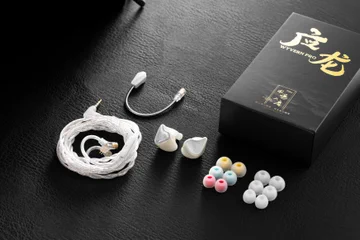
The LETSHOUER DZ4 is going to be polarizing for people you either are going to enjoy the presentation or hate it.
I loved the DZ4 uniqueness and presentation.
I would buy the wyvern just for the sake of getting an iem boom mic: the last time I checked, getting a boom-mic cable cost something like 50$; that makes the wyvern a super good deal.
But then, I still feel bad buying an iem with boom mic knowing I won’t use the iem…
Kinera Imperial Loki
- 6 Knowles BA + 4 Sonion EST + 1 6mm DD + 1 Bone Conduction Driver
- Impedance: 12 ohm
- Sensitivity: 107 dB
- Frequency Response: 20Hz-50kHz
-
Preamble:
“Putting thoughts to paper for the Imperial Loki review has been fraught with good intentions, and numerous fruitless nights, as I am immersed in, and fully lost in the music” -
Tuning:
It is my understanding the Loki release into North American and European markets was delayed to allow Kinera engineers to retune Loki slightly to better suit tuning preferences for these markets.
This Loki is “western” market tuned. -
Packaging, Build, Fit, Cables, etc:
Packaging:
I’m making an effort to make my reviews shorter and this one will be plenty long enough, so I’m not going into an in depth “unboxing”, suffice it to say the Loki unboxing experience is easily worthy of a flagship IEM.
Visit Kinera’s website if interested in more detail.
There are two details of the unboxing experience I would like to share.
Loki arrived with a bonus Kinera branded, travel size case, that will hold a good bit of gear.
And, in addition to the Effect Audio Ares S cable, there was another Kinera branded cable included.
I’ll touch on the cables more later, but, it is my understanding that these two extras will be included only with a limited number of the first sets sold.
Build and Fit:
Build and attention to detail is excellent. The shells are made from blue resin with metal flake, and this pair has custom hand painted faceplates. All art work is done in house by a very talented young lady.
The seams are invisible, and all surfaces are smooth with no sharp angles or edges.
The nozzles are also resin, with metal end caps.
Fit is very good overall with one caveat;
My hard to fit ears.
Those who have read my reviews before know I often mention my struggles with fitment, this is 100% a me thing, and does not reflect on the design of the IEM.
I’m focusing on fit here because the Loki features a contact style Bone Conduction driver. To fully appreciate the BC driver it is desirable to obtain a good fit, that goes deep enough to allow as much physical shell contact as possible with the ear.
Loki ships with a really good selection of high quality ear tips, so I believe the majority of users will find proper fitment quite easily.
For me, I tip rolled a lot, and in the end chose Sedna Xelastec for best fit, seal, anchor, and comfort.
Considering the driver count the shells are quite reasonable in size, I would say mid range, and are lightweight.
Cables:
Loki came with two high quality cables.
(I will note again, it is my understanding the extra cable is a limited time offering)
Affect Audio Ares S, 4 strand pure copper composition with 4.4 mm termination and 2 pin flush style connectors.
It is a nice cable, just a bit stiff.
Kinera branded mystery cable.
This cable isn’t available on Kinera website and I wasn’t able to source a lot of information on it.
I was told it is a pure copper/silver plated copper/gold plated copper hybrid composition.
- That is not officially confirmed.
It is fabric wrapped so no way to visually confirm.
4.4 mm termination and 2 pin recessed style connectors.
Also a nice cable, more supple than the Ares S, but, more prone to micro-phonics.
The Ares S leans more toward a reference/detail presentation.
Bass is tighter, more mid bass focused, sub bass is still strong, but less boomy, and doesn’t permeate across the head stage to any great degree.
Mids and vocals are forward and highly detailed and clear.
Treble and ultra highs have very good micro detail retrieval. Crisp, clear with good air and extension.
With the Ares S cable, on certain tracks that are recorded brighter and more forward I find the mids and vocals can become a bit too forward, and I pick up occasional hints of sibilance on cymbals and vocals, primarily female.
The Kinera cable has a warmer presentation.
More sub bass focus that carry’s deeper into the head stage. Sub/Mid separation is less defined, and some mid bass impact is lost.
Mids and vocals are still forward, but less so than with Ares S, and with some added warmth. Detail retrieval and clarity still very prominent.
Treble and ultra highs maintain micro detail retrieval, and are crisp clear and airy. But any hint of sibilance is gone.
Both cables synergize very well with Loki. Individual preference will vary between listeners.
I hope Kinera will chose to continue including both cables with Kinera.
Perhaps because I’m somewhat treble sensitive, my personal preference leans toward the Kinera cable offering.
The following sound impressions will be done with the Kinera cable.
Sources:
I tried Loki with various DAPs.
A&K SP2000T and Kann Max.
FiiO M11 Plus ESS.
Hiby RS6 and R6Pro 2.
Shanling M9.
Loki responds to the nuances of each source, but was not fussy on any that I tried.
In the end, for my personal preference, I liked Loki with the warmer sounding sources over the higher resolving sources.
I chose the Shanling M9 for the sound evaluation.
Equipment:
Kinera Imperial Loki aged 125+ hours.
Shanling M9 DAP, 4.4 balanced out, Low gain.
Kinera hybrid mystery cable.
Xelastec wide bore ear tips.
Bass:
The Bone Conduction driver is very well implemented. Stringed bass instruments have a realistic sense of resonance. Kick and tom drum strikes have a perceived sense of “air movement” within the head space.
Loki won’t necessarily satisfy diehard “bass focused” bass heads.
The bass is quality bass, delivered in the quantity called upon. Bass lovers rejoice.
Sub bass can bottom really low and deep, and when it does it also fills the head stage with lush, well managed, bass rumble, its presence further enhanced by the BCD.
Bass and upper bass is clean clear and fully detailed.
Individual string plucks and finger slides stand out, while resonance lingers.
Drum strikes have an airy resonance with a natural, boomy and full, tonality.
Wind instruments are full and throaty.
Bass as a whole follows the recorded source. It can sit lean and low, or rumble and thump with authority.
Mids:
Mids present forward, and somewhat elevated. (More so with Ares S cables)
Clean, clear, detailed, spacious, accurate.
The mids are nicely warmed by the bass overtones, but they rise above and present with excellent clarity, detail and energy.
Timbre is excellent, allowing for concise instrument individuality.
Vocals:
Vocals also present forward and elevated.
Clear, detailed, concise. Tonality is natural and accurate for both male and female.
On tracks with 2 or more vocalists/or backup vocalists, each singer enjoys individuality and space on stage.
Highs:
Highs are subdued slightly when using the Kinera cable.
They still have excellent clarity and micro detail retrieval, but upper highs and air are softened/warmed a bit. They are not harsh or sibilant.
There is no metallic BA timbre, and the EST drivers add just a bit of extra “zing” to cymbals, violins, harpsichord. etc.
Head Stage:
Loki Head Stage, or soundstage if you prefer, is expansive with excellent extension on all three axis.
I like good head stage, and for me, this is the heart of Loki’s strength.
Loki has one of the darkest, quietest backgrounds I have experienced, separation, layering and spaciousness is superb.
The holographic width, height, and depth in combination with a dark and spacious sound stage results in incredibly accurate imaging and instrument individuality and placement.
Summary:
My opening comment under preamble was really all that was needed as a review.
The Loki is an IEM that engages me and draws me into the music.
I literally had multiple 2-3 hour sessions where I never jotted a single notation for this review. I just got lost in the listen.
So, yes, for me the Loki is an excellent IEM choice, and fully worthy of flagship status IMHO.
Loki has no tuning nozzles, modules, or switches. Tailoring to personal preference is old school ear tips, sources, and cables.
Loki isn’t fussy with sources, it sounded good with all I tried, but source selection could/can/may be one aspect in finding “your sound”.
Kinera provides a wide variety of quality ear tips, and, for awhile at least, two cables in the box.
The Bone Conduction driver is very well implemented.
It adds a sense of vibration to sub bass, resonance to stringed instruments, and airy presence to thump and attack of percussion.
I’m not stuck on one certain sound signature.
Loki works very well for my personal listening enjoyment.
It’s an IEM that I can become immersed in. Fully enjoying listening to the music while “not intently listening” to the music. Just drifting along and hearing nuances I may have overlooked before.
I found Loki worked well with all genres I listened to. Rock, Blues, Jazz, Symphony, Country, Electronic, Rap.
Well recorded high resolution source files or streaming services reward the listener for the effort.
Loki is not hard to drive, but an extra notch or two toward mid point on the volume knob helps wake up all the drivers.
Comparisons:
FiR Audio XE6 CIEM:
1 kinetic hybrid Bone Conduction DD and 1 open BA bass.
2 open BA mids
1 open BA highs
1 EST ultra highs.
Gold ATOM module (most bass)
The XE6 is definitely more bass focused than Loki. You are immediately drawn to the impactful bass presentation.
XE6 kinetic sub bass is more “ambient” sounding, like it’s coming from outside the head space, as well as from within.
Mids and vocals are somewhat forward and elevated they are not as detailed as Loki.
Highs are also not as clear, bright or detailed as Loki.
Head stage is good but not as deep, nor as open, spacious, or holographic as Loki.
More smoky night club, than symphonic auditorium.
These are differently tuned IEMs.
XE6 is bass oriented and energetic. Like the kick in the behind from that first cup of coffee in the morning. Makes you want to get moving.
(Note: XE6 has two other modules that shift the signature away from bassy which allows the mids highs more breathing room)
Loki is more audiophile tuned, and more detailed, just relax and drift with the musical journey.
Empire Ears EVO UIEM:
2 W9+ Sub Woofers
5 proprietary BA
1 Weapon X 10.9mm Bone Conduction
EVO is also tuned toward more Bass focus. It is less Sub Bass focused than XE6 with the gold module installed. EVO has more mid bass presence.
The mids and vocals are clearer and have more detail than XE6, but less than Loki.
Highs have more micro detail than XE6. EVO is brighter and airier in the highs than both XE6 and Loki.
Soundstage is more open and holographic than XE6, but Loki prevails over both with best soundstage.
EVO slots in between the XE6 and Loki with respect to tuning characteristics.
Overall Kinera Loki is the best all rounder for me. But I like all three and daily choice between three would depend on my mood, at the time.
HISENIOR febos
MEGA 5P EST
7th ANNIVERSARY EDITION
1 x 10mm custom Bio Cellular Dynamic Driver for bass.
2 x Sonion BA for mids/highs.
2 x Sonion EST Super tweeters for Ultra High.
Freq Response 10Hz-50Khz
Sensitivity 110dB/mW
Impedance 25Ω
Preamble:
Thanks go out to Gareth and Hisenior for choosing me to participate in the Fan Discount offer.
The 5P EST 7th anniversary edition ships with the White Whale cable.
Fit and Finish:
5P EST has a quality look and feel.
Shells are smooth and nicely sculpted with no angular edges.
The resin shells and face plate are grey, with the faceplate differentiated only by the addition of some metal flake and a subtle “febos” logo in silver. A classic, very refined look IMO.
Metal nozzles, a single vent hole, and a mild “wing” also adorn the shell.
5P EST fit my larger ears easily and comfortably. The wings work well for me and help maintain a good insertion angle.
5P EST ships with their signature “pelican style” carry case and includes a generous selection of ear tips, cleaning cloth, and cable clip.
The case provides excellent protection if you are going to toss it in a kit bag or backpack, but it’s not practical for most pockets.
Cable:
White Whale is a very nice SPC cable.
Two thick strands twisted together, and a single strand above the splitter.
4.4mm Termination, 2 pin flush connectors, Y splitter, and chin toggle are all metal.
Ear hooks work well to support the IEM in ear.
*Note: White Whale has a nice synergy with 5P EST, however I found a couple of my 3rd party cables brought the sound closer to my personal preference.
This is of course personal and very much subjective.
*I will share a few thoughts on alternate cables following the initial sound evaluation below.
**HiSenior Trivia Moment:
febos is a sub brand of HiSenior and the name is an acronym for:
Feel (the) Beauty Of Sound. **
I tried a few different sources with 5P EST and found my preference leaned toward more resolving sources.
So I choose to use the AK Kann Max for the sound evaluation.
Equipment:
-HiSenior febos Mega 5P EST aged 120 plus hours.
-Astell and Kern Kann Max, Low Gain.
-4.4mm White Whale SPC cable.
-Sedna Xelastec ear tips .
Bass:
Is warm and lush, it has a strong sub bass presence. It’s nicely textured and can pull very low.
It does however bloat or “permeate” the entire head stage, casting a thin “transparent veil” across the sound signature.
Mid and upper bass are recessed.
Kick drums have good impact and resonance, but attack on tom and snare drums is somewhat softened by the sub bass carry over.
On familiar tracks where I typically clearly hear finger slides and string resonance on bass instruments, these details are muted.
Still, it is very good bass, especially if you like a strong sub bass presence.
Mids:
Rise up through bass. They are warmed by the bass over tones. While they do present with good clarity and detail, on strong bass tracks some detail retrieval gets buried.
Vocals:
Vocals present slightly elevated and forward. They are clear and detailed and, for the most part, both male and female present as accurate and natural.
Some female vocals can exhibit some additional “huskiness”.
Highs:
Highs are clear and bright. There is no hint of BA timbre, and the EST drivers are well implemented in my opinion.
There is no harshness or sibilance.
However I feel the high end is also affected by the sub bass presence, and is robbed of some detail, sparkle, and air.
Head Stage:
The head stage is more intimate than expansive. I perceive it to present more forward in the head space.
Left to right extension is good and it has good height. Front to rear depth is average.
Stage is not overly spacious, but separation of instruments is good.
On busy tracks there is little or no congestion.
Imaging and layering are good and individual instrument placement is accurate.
Summary:
You may think from the commentary above I don’t care much for the Mega 5P EST.
That is not the case, it has a warmer sound signature, and delivers a very enjoyable, lay back, relax, and listen experience.
With 2 BA and 2 EST handling the high end, I had initial expectations of a bit more detail retrieval and high end extension.
It’s good, I was just expecting more.
The 5P EST isn’t overly difficult to drive, but it does like some extra power and wakes up nicely when applied.
On all the sources (DAPs) I tried I found I was typically in the 40-60% volume range at low gain setting. I didn’t try lower powered sources like a phone, or phone dongle combination, but there is a possibility that lower powered sources may struggle to drive 5P EST to its potential.
I do own the OG Mega 5P, but it’s on loan to a family member so I don’t have it available to do a side by side comparison, and will refrain from commenting based on memory.
I’m not looking to start the dreaded cable debate, if you don’t hear differences between cables I fully respect your experience, and you can choose pass over the remainder of this review if you prefer.
Cables:
I mentioned earlier I didn’t feel the White Whale cable was necessarily the best synergy with the 5P EST, this being 100% relative to my personal preference. YMMV.
I rolled a dozen or so cables with the 5P EST. Pure copper, pure silver, SPC, and precious metal blends. From ultra budget to more expensive offerings.
I’m not going to detail all of them, just one, of the few, that I found had a synergy with 5P EST that better fit my preference.
The FiiO LC-RE precious metal cable is one of the cables that I found tailored the Mega 5P EST closer to my preferred sound.
This cable retails at approx. 1/3 the the retail cost of the 5P, so, I want to clarify that I am not suggesting anyone go out and purchase this cable, it just happens to be a cable that I own, and it works well with this IEM; for me.
Sub Bass tightens up and decays quicker but still retains a strong presence.
Using a 20Hz sub bass test track confirms sub bass does not pull as low as with the stock cable.
Mid bass is still recessed but has more presence.
Kick drums still have good impact but less resonance. Toms and snares have a bit more impact.
The “veil” is lifted off the mids and highs.
Mids are still warm but clarity and detail is improved.
Vocals remain elevated but they are a bit less forward. Male and Female vocals gain some additional clarity but remain natural and accurate.
Highs also gain clarity and detail, but the ultra highs benefit the most with improved sparkle and air.
Still no hint of harshness or sibilance.
Head stage doesn’t change a lot.
I do perceive the stage to present further back in the head space making it feel somewhat less intimate, and a bit more spacious.
Final Thoughts:
Finding a cable that attenuated the sub bass just enough to reduce the sub bass bloat and give the mids, vocals, and highs room to breath was a welcome find for me.
It showcased what the Mega 5P EST is truly capable of.
